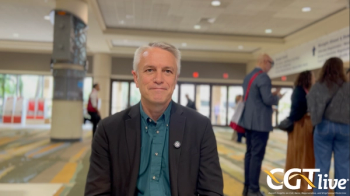
Axi-Cel Shows Favorable Outcomes in Large B-Cell Lymphoma Regardless of Race, Ethnicity
No differences were found in overall survival and progression free survival across races.
In patients with large B-cell lymphoma (LBCL), treatment with axicabtagene ciloleucel (axi-cel;Yescarta; Kite Pharma, Gilead) was associated with a favorable overall survival (OS), progression free survival (PFS), and safety profile regardless of race or ethnicity, according to data from a real-world setting presented at the
“No notable differences in outcomes were observed for Hispanic or Asian patients,” wrote Frederick L. Locke, MD, of the H. Lee Moffitt Cancer Center & Research Institute in Tampa, Florida, and colleagues. “Lower response rates in African American patients noted here warrant further investigation including any underrepresentation not explained by a lower incidence rate for diffuse LBCL, access to care, and disease burden.”
In April, the FDA approved axi-cel for the treatment of adult patients with LBCL that is refractory to first-line chemoimmunotherapy or who experienced relapse within 12 months of first-line chemoimmunotherapy.2
Locke and colleagues explained that there is a lack of data on outcomes by race and ethnicity from studies of CAR T-cell therapies. They examined outcomes by race (African American or Asian vs White) and ethnicity (Hispanic vs. non-Hispanic) among 1389 patients with LBCL who received axi-cel in a real-world setting between October 2017 and August 2020.
Of the patients, 1127 (81%) were White, 81 (6%) were Asian, and 70 (5%) were African American; 152 (11%) were Hispanic including 104 White, 2 Black, and 1 Asian Hispanic. Patients with a history of prior nonhematopoietic cell transplantations cellular therapy, primary central nervous system lymphoma, and unknown comorbidity were excluded from the trial. African American patients compared with White patients were younger (median age 55.5 vs. 62.8 years), more likely to have pulmonary impairment, (41% vs. 28%) and tended to have longer time from diagnosis (≥ 12 months 71% vs. 59%). Hispanic patients were younger (median age 58.5 vs. 62.6 years) than non-Hispanic patients.
The median follow-up was 12.7 months. Outcomes included overall response rate (ORR), complete response (CR) rate, duration of response (DOR), PFS and OS, grade ≥ 3 cytokine release syndrome (CRS), and immune effector cell-associated neurotoxicity syndrome (ICANS). ORR and CR were evaluated in patients with at least 180 days of follow-up.
The ORR was 74% (CR 57%, 12-month PFS and OS 48% and 63%) for White, 57% (CR 45%, 12-month PFS and OS 36% and 62%) for African American, 67% (CR 53%, 12-month PFS and OS 55% and 65%) for Asian and 73% (CR 55%, 12-month PFS and OS 50% and 65%) for Hispanic patients. Grade ≥ 3 CRS and ICANS occurred in 7% and 18% of African American, 10% and 19% of Asian, and 8% and 27% of White patients, respectively. Hispanic patients had lower rates of grade ≥ 3 CRS and ICANS (4% and 15%) compared with non-Hispanic patients (9% and 27%).
African American race was associated with inferior ORR (OR 0.40; 95% CI, 0.24-0.69) and CR rate (OR 0.55; 95% CI 0.32-0.93) compared with White. Asian patients had favorable DOR compared with both White race (HR 0.46; 95% CI 0.24-0.87) and African American patients (HR 0.39; 95% CI 0.17-0.88).
No statistical differences were found in OS and PFS across races, nor in any efficacy outcome between Hispanic and non-Hispanic patients. Asian (OR 0.52; 95% CI 0.29-0.96 vs. White) and Hispanic patients (OR 0.51; 95% CI 0.31-0.85 vs. non-Hispanic) had lower risk of grade ≥ 3 ICANS.
For more coverage of ASCO 2022, click here.
REFERENCES
1. Locke F, Siddiqi T, Jacobson C, et al. Real-world outcomes of axicabtagene ciloleucel (Axi-cel) for the treatment of large B-cell lymphoma (LBCL) by race and ethnicity. Presented at: 2022 ASCO Annual Meeting, June 3-7, 2022. Abstract #7571
2. FDA approves axicabtagene ciloleucel for second-line treatment of large B-cell lymphoma. News Release. April 1, 2022. U.S. Food & Drug Administration. https://www.fda.gov/drugs/resources-information-approved-drugs/fda-approves-axicabtagene-ciloleucel-second-line-treatment-large-b-cell-lymphoma .
Newsletter
Stay at the forefront of cutting-edge science with CGT—your direct line to expert insights, breakthrough data, and real-time coverage of the latest advancements in cell and gene therapy.
















































